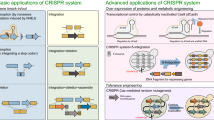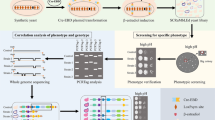Abstract
In bioprocesses, a microorganism with high tolerance to various stresses would be advantageous for efficient bio-based chemical production. Yeast Saccharomyces cerevisiae has long been used in the food industry because of its safety and convenience, and genetically engineered S. cerevisiae strains have been constructed and used for the production of various bio-based chemicals. In this study, we developed a novel genome shuffling method for S. cerevisiae using CRISPR-Cas. By using this, the thermotolerant mutant strain T8-292, which can grow well at 39 °C, was successfully created. The strain also showed higher cell viability in low pH and high ethanol concentration. In addition, the differences in genome structure between mutant and parent strains were suggested by random amplified polymorphic DNA PCR method. Our genome shuffling method could be a promising strategy for improvement of various stress tolerance in S. cerevisiae.







Similar content being viewed by others
References
Nevoigt, E. (2008). Progress in Metabolic Engineering of Saccharomyces cerevisiae. Microbiology and Molecular Biology Reviews, 72(3), 379–412.
Ostergaard, S., Olsson, L., & Nielsen, J. (2000). Metabolic Engineering of Saccharomyces cerevisiae. Microbiology and Molecular Biology Reviews, 64(1), 34–50.
Abdel-Banat, B. M. A., Hoshida, H., Ano, A., Nonklang, S., & Akada, R. (2010). High-temperature fermentation: how can processes for ethanol production at high temperatures become superior to the traditional process using mesophilic yeast? Applied Microbiology and Biotechnology, 85(4), 861–867.
Gao, L., Liu, Y., Sun, H., Li, C., Zhao, Z., & Liu, G. (2016). Advances in mechanisms and modifications for rendering yeast thermotolerance. Journal of Bioscience and Bioengineering, 121(6), 599–606.
Doğan, A., Demirci, S., Aytekin, A. Ö., & Şahin, F. (2014). Improvements of tolerance to stress conditions by genetic engineering in Saccharomyces cerevisiae during ethanol production. Applied Biochemistry and Biotechnology, 174(1), 28–42.
Steensels, J., Snoek, T., Meersman, E., Nicolino, M. P., Voordeckers, K., & Verstrepen, K. J. (2014). Improving industrial yeast strains: exploiting natural and artificial diversity. FEMS Microbiology Reviews, 38(5), 947–995.
Sridhar, M., Sree, N. K., & Rao, L. V. (2002). Effect of UV radiation on thermotolerance, ethanol tolerance and osmotolerance of Saccharomyces cerevisiae VS1 and VS3 strains. Bioresource Technology, 83(3), 199–202.
Abe, H., Fujita, Y., Takaoka, Y., Kurita, E., Yano, S., Tanaka, N., & Nakayama, K. (2009). Ethanol-tolerant Saccharomyces cerevisiae strains isolated under selective conditions by over-expression of a proofreading-deficient DNA polymerase δ. Journal of Bioscience and Bioengineering, 108(3), 199–204.
Zhang, Y. X., Perry, K., Vinci, V. A., Powell, K., Stemmer, W. P. C., & del Cardayre, S. B. (2002). Genome shuffling leads to rapid phenotypic improvement in bacteria. Nature., 415(6872), 644–646.
Shi, D., Wang, C., & Wang, K. (2009). Genome shuffling to improve thermotolerance, ethanol tolerance and ethanol productivity of Saccharomyces cerevisiae. Journal of Industrial Microbiology & Biotechnology, 36(1), 139–147.
Paques, F., & Haber, J. E. (1999). Microbiology and Molecular Biology Reviews, 63, 349–404.
Cameron, J. R., Loh, E. Y., & Davis, R. W. (1979). Evidence for transposition of dispersed repetitive DNA families in yeast. Cell., 16(4), 739–751.
Atienzar, F. A., & Jha, A. N. (2006). The random amplified polymorphic DNA (RAPD) assay and related techniques applied to genotoxicity and carcinogenesis studies: a critical review. Mutation Research, 613(2-3), 76–102.
Xu, K., Ren, C., Liu, Z., Zhang, T., Zhang, T., Li, D., Wang, L., Yan, Q., Guo, L., Shen, J., & Zhang, Z. (2015). Efficient genome engineering in eukaryotes using Cas9 from Streptococcus thermophilus. Cellular and Molecular Life Sciences, 72(2), 383–399.
Chen, D. C., Yang, B. C., & Kuo, T. T. (1992). One-step transformation of yeast in stationary phase. Current Genetics, 21(1), 83–84.
Yamada, R., Wakita, K., & Ogino, H. (2017). Global metabolic engineering of glycolytic pathway via multicopy integration in Saccharomyces cerevisiae. ACS Synthetic Biology, 6(4), 659–666.
Couto, M. M. B., van der Vossen, J. M. B. M., Hofstra, H., & Huis in’t Veld, J. H. J. (1994). RAPD analysis: a rapid technique for differentiation of spoilage yeasts. International Journal of Food Microbiology, 24(1-2), 249–−260.
Rasband, W. S. ImageJ, U. S. National Institutes of Health, Bethesda, Maryland, USA, https://imagej.nih.gov/ij/, 1997–2018. Accessed in 2016.
Li, J., Wang, S., VanDusen, W. J., Schultz, L. D., George, H. A., Herber, W. K., Chae, H. J., Bentley, W. E., & Rao, G. (2000). Green fluorescent protein in Saccharomyces cerevisiae: real-time studies of theGAL1 promoter. Biotechnology and Bioengineering, 70(2), 187–196.
Caspeta, L., Chen, Y., Ghiaci, P., Feizi, A., Buskov, S., Hallström, B. M., Petranovic, D., & Nielsen, J. (2014). Altered sterol composition renders yeast thermotolerant. Science., 346(6205), 75–78.
Jasin, M., & Rothstein, R. (2013). Repair of strand breaks by homologous recombination. Cold Spring Harbor Perspectives in Biology, 5(11), a012740.
Lieber, M. R. (2010). The mechanism of double-strand DNA break repair by the nonhomologous DNA end-joining pathway. Annual Review of Biochemistry, 79, 181–211.
Kraus, E., Leung, W. Y., & Haber, J. E. (2001). Break-induced replication: a review and an example in budding yeast. PNAS., 98(15), 8255–8262.
Williamson, V. M. (1983). Transposable elements in yeast. International Review of Cytology, 83, 1–25.
Wilke, C. M., & Adams, A. (1992). Fitness effects of Ty transposition in Saccharomyces cerevisiae. Genetics., 131(1), 31–42.
Ma, M., & Liu, Z. L. (2010). Mechanisms of ethanol tolerance in Saccharomyces cerevisiae. Applied Microbiology and Biotechnology, 87(3), 829–845.
Caspeta, L., Castillo, T., & Nielsen, J. (2015). Frontiers in Bioengineering and Biotechnology, 3, 184.
Stanley, D., Bandara, A., Fraser, S., Chambers, P. J., & Stanley, G. A. (2010). The ethanol stress response and ethanol tolerance of Saccharomyces cerevisiae. Journal of Applied Microbiology, 109(1), 13–24.
Kitichantaropas, Y., Boonchird, C., Sugiyama, M., Kaneko, Y., Harashima, S., & Auesukaree, C. (2016). Cellular mechanisms contributing to multiple stress tolerance in Saccharomyces cerevisiae strains with potential use in high-temperature ethanol fermentation. AMB Express, 6(1), 107.
Carmelo, V., Bogaerts, P., & Sá-Correia, I. (1996). Activity of plasma membrane H + -ATPase and expression of PMA1 and PMA2 genes in S accharomyces cerevisiae cells grown at optimal and low pH. Archives of Microbiology, 166(5), 315–320.
Andrighetto, C., Psomas, E., Tzanetakis, N., Suzzi, G., & Lombardi, A. (2000). Randomly amplified polymorphic DNA (RAPD) PCR for the identification of yeasts isolated from dairy products. Letters in Applied Microbiology, 30(1), 5–9.
Cenis, J. L. (1993). Identification of Four MajorMeloidogynespp. by Random Amplified Polymorphic DNA (RAPD-PCR). American Physical Society, 83(1), 76–80.
Acknowledgments
This work was partly supported by the Japan Society for the Promotion of Science KAKENHI (grant number JP18K14069) and KAKENHI Specific Support Operation of Osaka Prefecture University to RY.
Author information
Authors and Affiliations
Corresponding author
Additional information
Publisher’s Note
Springer Nature remains neutral with regard to jurisdictional claims in published maps and institutional affiliations.
Electronic Supplementary Material
ESM 1
(DOCX 111 kb)
Rights and permissions
About this article
Cite this article
Mitsui, R., Yamada, R. & Ogino, H. Improved Stress Tolerance of Saccharomyces cerevisiae by CRISPR-Cas-Mediated Genome Evolution. Appl Biochem Biotechnol 189, 810–821 (2019). https://doi.org/10.1007/s12010-019-03040-y
Received:
Accepted:
Published:
Issue Date:
DOI: https://doi.org/10.1007/s12010-019-03040-y




